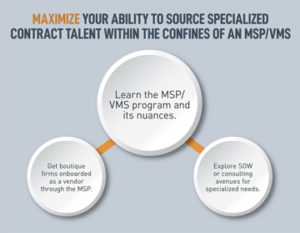(Even When Going Through an MSP/VMS)
A recent NPR/Marist survey reveals that 20 percent of work in the U.S. is fulfilled by contract workers. So, no matter what industry your business serves, chances are you regularly employ contractors to augment your permanent workforce. This reality creates a continual need to source consultants, whether it be through an MSP (Managed Services Provider) / VMS (Vendor Management System) or a boutique staffing firm.
The use of an MSP/VMS has increased dramatically in the last ten years; the threshold for engaging with an MSP used to be approximately $50 million a year in contract staffing spend, but that number has significantly decreased, and many small to medium-sized companies utilize an MSP program. Despite all the benefits of an MSP/VMS, it can present a challenge to internal hiring managers who need to find contractors quickly, with a very specific skill sets.
“Some companies are much more strict and rigid than others when it comes to MSP utilization,” said Tim Ozier, senior director of contract staffing sales for MRINetwork. “Some junior level managers may also be more reluctant to try and work outside the MSP program than their senior colleagues.”
Regardless of how your company manages its contingent workforce, Ozier recommends taking the following steps to ensure you have an efficient process for sourcing contractors:
-
Become very familiar with the MSP/VMS program and its nuances.
You might find that the program allows you to attract the contract talent you need, in a timely manner, at the right price. However, many managers have previously established relationships with smaller, boutique recruiting firms with whom they want to continue working.
-
Try to get boutique firms onboarded as a vendor through the MSP program.
This can be time-consuming and possibly unsuccessful if the smaller firms cannot comply with the vendor requirements. Essentially, you’ll need to justify why it’s critical to bring in highly specialized talent that can’t be sourced through the MSP program. To accomplish this, learn the internal processes and justifications for using non-preferred suppliers. Exceptions can be made and even when the list of preferred vendors are locked down, there is typically a second tier of boutique providers that the MSP can turn to for meeting mission-critical business needs.
-
Utilize the boutique firm for consulting services or SOW projects.
These services frequently fall outside the auspices of the MSP program.
In some cases, it can help the hiring manager make a case for using an outside firm if he/she already has an excellent candidate from the firm. The company will usually have another vehicle outside of the MSP for more strategic or specialized business needs. Many of those needs can be met by a staffing provider.
“Ultimately, it’s key that managers talk to other internal groups, to gain insight on all the available staffing options,” concluded Ozier. “There are possibilities that are not always made public, and when there is enough pain regarding sourcing contingent talent, these opportunities open up.

